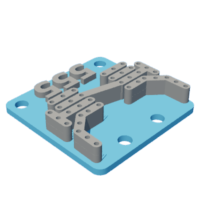Introduction: Bits4Bots - 3D Printed 555 Timer - Flashing LED - Conductive Filament
Rapid circuit prototype with a 3D printer and conductive filament.
This project features a simple circuit designed to explain the working and use of a 555 timer IC.
The connection used is credited to this blog LED Flasher Circuit
The 555 timer was one of the first IC chips I learned to use in a project back when I attended community college. I learned to read the datasheet and create my first flashing LED! This is a good place to start for those new to electronics.
*I recommend reading the 555 timer datasheet to learn more!
Follow us for more cool projects and visit us at www.bits4bots.com
Supplies
- 3D printer
- Proto-Pasta filament
- eSun PLA filament
- 555 timer IC
- 5mm LED or similar i.e 3mm, 10mm
- 100uF capacitor - C1 * Can be SAT (selected at testing)
- x2 resistors (1K) - R1 & R3
- 1 resistor (100K) - R2 *Can be SAT (selected at testing)
- 9V battery
- 9V snap connector
Step 1: 3D Printed Circuit Board
This part has been done for you. The design was created in Autodesk Inventor and made available in TinkerCad.
Download and print the 3D file(s) here or from Thingiverse I designed the assembly for one single print
(1hr 30min) or in two parts 45min each:
- Base 30mm x 30mm
- Traces for testing purposes (different Z-axis height layers for various conductivity)
For TinkerCad users see link: Tinkercad
Note: When the print is 7% to 8% complete, the conductive filament should follow. Here is a great Instructable for welding 3D filament Filament Fuser.
*I simply snipped off the colored PLA with a wire cutter, then guided the conductive filament into the 3D printer until the extruder accepted (grabbed) it.
Attachments
Step 2: Wire the Board
After the print is complete the top layers of the board should have 3mm+ conductive filament.
Pin 2 and 6 are connected. All other pin connections will need to be made manually.
Place 555 timer onto 3D printed board and press firmly to make a strong connection. Careful not to bend the legs!
1. Connect pin 4 and 8 together with a male to male jumper or wire. *tinned wire for optimization
2. Connect LED ground leg to pin one.
3. Connect R3 (1K ohm) to +itive lead of LED, and then to pin 3.
4. Connect R1 between pin 6 and 7
5. Connect R2 between pin 7 and 8
6. Place C1 between pin 1 and 2 *-itive lead to pin 1 (for polarized capacitors)
7. Note: Pin 5 will not be connected (this is also called floating)
Step 3: Test the Circuit
The last step is to power the circuit. 5V-9V is a good value to use for the power supply. Here I used a 9V battery and snap connector.
Connect negative lead to pin 1. Connect positive lead to pin 8
Please like, share, or comment. Find us on all social media! Check us out on Tindie
**Did we make a mistake? Let us know :)
Step 4: Research the Conductive Filament
Before we designed our 555 timer circuit we conducted a search for conductive 3D filament. There are several companies that you can choose from. We decided to go with Proto Pasta. The details for conductivity are below:
- Volume resistivity of molded resin (not 3D Printed): 15 ohm-cm
- Volume resistivity of 3D printed parts perpendicular to layers: 30 ohm-cm
- Volume resistivity of 3D printed parts through layers (along Z axis): 115 ohm-cm
- Resistance of a 10cm length of 1.75mm filament: 2-3kohm
- Resistance of a 10cm length of 2.85mm filament: 800-1200ohm
CHALLENGE:
Now that the resistivity is known the next challenge is to calculate the resistance in each trace used.
I measured 28K Ohms in the curved traces on pin 1 and on pin 8. These are the traces that connect the power supply.
The shortest traces measure 1K Ohms. Pin 4 and pin 5.
The trace from pin 2 to pin 6 is TBD.
The T-shaped trace, pin 3 (trigger) and pin 7 need to be measured.
***Increased layers on the Z-axis = increase the resistance. Less layers can be used to best resemble standard wires such a copper or other metals presented in general printed circuit boards. This portion of the 3D PCB is a work in progress.
In addition, advanced users can accurately determine exact wire (3D trace) resistance via circuit simulation software that can perform line calculations i.e. NI Multisim, ADS (Keysight), and others.
Step 5: Calculate LED Flash Time
For the 555 Timer IC you, the designer, will calculate on/off flash time. The link below is a great way to calculate your design or check your math work. 555 Astable Circuit Calculator
- Increasing C will increase the cycle time (and hence, reduce the frequency).
- Increasing R1 will increase Time High (T1), but will leave Time Low (T0) unaffected.
- Increasing R2 will increase Time High (T1), increase Time Low (T0) and decrease the duty cycle (down to a minimum of 50%)
By hand you can use these formulas to calculate the LED time on/off in seconds.
Time high (on) = 0.7 * (R1 + R2) * C1
Time low (off) = 0.7 * R2 * C1

Participated in the
Explore Science Challenge














